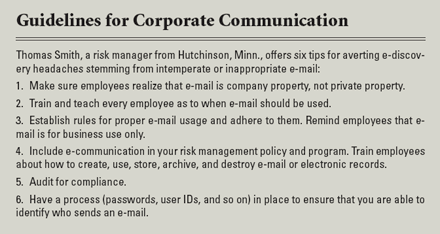In litigation, the discovery process has always been expensive.With computers and digital technology, though, there are addedlayers of complexity and cost. Discovery no longer involves justreviewing boxes and boxes of papers. Regardless of the dispute —product liability, employment practices, or directors and officers— discovery now entails exhaustive searches of electronic data.This means sifting through computer hard drives, thumb drives,servers, tapes, e-mail strings, archives, instant messengerdialogue, and so on. Searching electronic data sources consumeshuge chunks of time and dollars.
|Now let's consider that 36 billion e-mails are transmitted eachday. This pace rises 20 percent annually. Ninety-three percent ofall information is now stored digitally, with 70 percent of thatnever actually printed. A 2007 Kroll survey revealed thefollowing:
- Twenty-five percent of U.S. corporate in-house counsel claim tobe current with all case-law developments and regulations relatingto electronically stored information (ESI).
- Only half of the respondents said that their organizations hada policy regarding ESI.
- Seventy-five percent report losing time and money because ofinefficient ESI processes.
Risk managers simply must seek ways to tame e-discovery costs asa volatile component of litigation expense. This is true regardlessof whether a risk manager's company is fully insured, self-insured,or a blend of the two. Even if the risk manager's organization hasfirst-dollar insurance coverage, hemorrhaging e-discovery costs canspike an account's loss ratio. This, in turn, will increase thecost of risk, inflate renewal pricing terms, or perhaps even renderan account uninsurable. If a risk manager is self-insured, thene-discovery costs represent a torpedo hit to expense budgetswithout any cushion from insurance. While risk managers juggle manyballs, taming e-discovery costs is within the risk manager'spurview, whether insurance is at play or not.
|Thus, risk managers seek to tame the electronic discovery beast.One approach is to hold outside legal defense counsel accountableas a partner in managing e-discovery costs. Most likely, defensecounsel will be instrumental in both selecting the e-discoveryvendor and overseeing electronic discovery. If defense attorneysview e-discovery costs as a pure pass-through to the client, theywill have limited incentive to embrace efficient, cost-savingprocesses. The key is to fully comply with discovery demandswithout spinning wheels, wasting time and money, all while avoidingexpensive wild goose chases. Make defense lawyers feel that theyare partners collaborating with the risk manager in amelioratinge-discovery costs.
|In electronic discovery, the most expensive component is thepeople component. Risk managers must assess the vast number ofdocuments requiring human review multiplied by the hourly rate toavoid exponential cost. A key step for taming e-discovery expensesis to identify early on the kinds of documents that the riskmanager's company must collect. This way, counsel gathers onlyrelevant documents and the client avoids expensive diversions. Therisk manager must make sure that somebody accurately defines thescope of the document universe.
|Either directly or indirectly, the risk manager's company mustwork with an outside vendor to assist the electronic discoveryprocess. Risk managers must observe a vetting process. Does theprovider/vendor have the expertise and track record in providingelectronic discovery? Do they have authoritative representativeswho can testify before judges about processes and results?Increasingly, judges demand competence in electronic discovery fromattorneys appearing before them.
|Another tactic to tame e-discovery costs is to seek early “meetand confer” sessions with opposing counsel. Often, opposingattorneys can agree to narrow the scope of e-discovery throughthese efforts. There is no fool-proof guarantee, but frequentlythis can circumscribe the orbit of electronic discovery.
||Risk managers must make sure that someone in the IT departmentknows enough of the rules of civil procedure to capture and producecomputer files, which can later be entered into evidence. Inaddition, risk managers must identify an in-house attorney who canexplain the company's IT architecture. Further, the risk managermust ensure that the company has a clear document retention policy(refer to the sidebar for guidelines). This policy should factor inall appropriate regulatory requirements and have mechanisms toensure enforcement of document retention guidelines.
|Insurance to Fund e-Discovery
|Not to overlook the obvious, but one way to tame e-discoverycosts is to shift that expense to an insurance carrier. Clearly,this tactic is not available to companies that totally self-insure.For most firms that buy insurance coverage, they might make acompelling argument that e-discovery is a legitimate portion of thedefense costs that an insurance company is obligated to pay. Thisshould not be a difficult argument conceptually. Practically,however, an insurer may balk — or gag — when it sees thee-discovery price tag.
|Just as a liability insurance policy would obligate theinsurance company to pay legal fees and related expenses for paperdiscovery, there is no reason why electronic discovery required inthe defense effort would be excluded. Ideally, the risk manager hasdefense-outside-limits coverage pertaining to legal costs. If not,then the risk manager and the policyholder have a differentdecision. For instance, if defense costs erode policy limits, thendo you want to spend those defense dollars on electronic discoveryor conserve those policy dollars for settlements or otherdefense-related activities? This is a rhetorical question, but onewith which the risk manager will have to grapple.
|Another factor entering into the decision is whether the riskmanager's company has excess coverage above a primary layer and canshift e-discovery costs to one or more excess carriers.
|For the risk manager and company with low policy limits and/ordefense-within-limits (also known as “self-eroding”) coverage,there may be reasons to reconsider tagging e-discovery costs to theinsurance carrier. Ultimately, the theory behind insurance is thateveryone eventually pays their own freight. Allocating sizablee-discovery costs to an insurance carrier will increase anaccount's loss ratio, one factor among many that will be weighed inthe cost of future insurance renewals. Depending upon how importantit is for a risk manager to keep the loss ratio low, thepractitioner may decide to either forego shifting e-discovery coststo an insurance company or perhaps explore e-discovery cost-sharingbetween the insurance company and the policyholder.
|Many risk managers may conclude that the “e” in e-discoverystands for “expensive.” Paying attention to the process andfollowing these strategies, however, can help transform that “e”from “expensive” to “efficient.”
|
Want to continue reading?
Become a Free PropertyCasualty360 Digital Reader
Your access to unlimited PropertyCasualty360 content isn’t changing.
Once you are an ALM digital member, you’ll receive:
- All PropertyCasualty360.com news coverage, best practices, and in-depth analysis.
- Educational webcasts, resources from industry leaders, and informative newsletters.
- Other award-winning websites including BenefitsPRO.com and ThinkAdvisor.com.
Already have an account? Sign In
© 2024 ALM Global, LLC, All Rights Reserved. Request academic re-use from www.copyright.com. All other uses, submit a request to [email protected]. For more information visit Asset & Logo Licensing.








